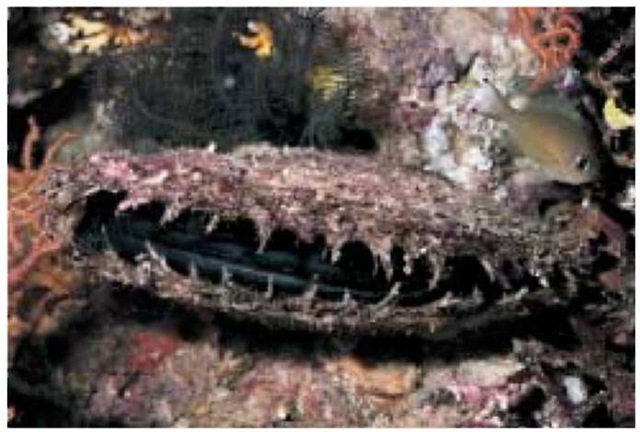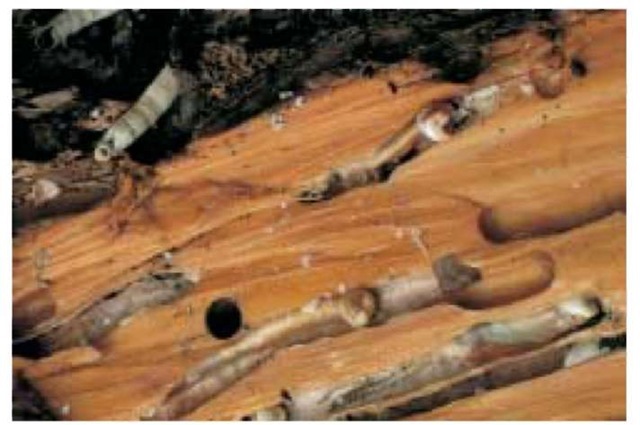The influence of protostomes on humans
Many protostomes are small in size and often overlooked among larger natural features and more charismatic creatures of the surrounding world. However, protostomes have played a variety of important roles in human cultures, economies, and health since ancient times. Some protostome species have instilled a sense of fear in the minds of humans, while others have represented fortune. Some have provided nourishing sources of food, while others have advanced medical treatments. Still other protostomes influence ecosystem functions, both for the benefit and to the detriment of humans. Although protostomes have figured prominently in societies throughout the course of history, many are threatened by current human activities, and conservation efforts are important for ensuring the future survival of some species.
Cultural importance of protostomes
Both ancient and modern societies have used protostomes for a variety of purposes. Cowry shells, for example, became the first medium of exchange, or money. These shells were originally used for barter in China as early as 1200 B.C., and their function as currency continued in parts of Africa through the nineteenth century. Wealthy Chinese individuals were even buried with cowries in their mouths to ensure they would have the ability to make purchases in their afterlife. Cowries also have been worn as ornaments by members of many cultures, and women of the ancient Roman city of Pompeii believed that the shells served a functional role by preventing sterility.
Marine gastropods, particularly those of the genus Murex, were used to obtain a royal purple dye, known as Tyrian purple. References to this dye date back to 1600 B.C., and its production probably represents one of the earliest cultural and commercial uses of marine mollusks. In the battle of Actium of 31 B.C., Antony and Cleopatra displayed sails of Tyrian purple on their sailing vessels. In some ancient societies, only royalty and idols were allowed to wear cloth of this color. The industry to produce Tyrian purple dye flourished throughout the world until the decline of the Roman empire in the mid-fifteenth century, at which time it was replaced by cheaper dyes, including some obtained from other protostomes.
In addition, some species of protostomes have provided important sources of food in many societies. Shellfish such as clams, mussels, and oysters are consumed throughout much of the world, as are crustaceans such as shrimp, lobsters, and crabs. Snails are considered a delicacy in some countries, where they appear on menus as “escargot.” Although they may resemble creatures from another era, horseshoe crabs are highly valued in many Asian markets.
Many protostomes are consumed by humans, and as such they support major fisheries and traditional livelihoods. In 2001 protostomes such as shrimp, clams, squids, and lobsters represented over 26% of all marine fishery harvests. In addition, more than 13 million tons of these species were produced in aquaculture operations. Both wild harvests and captive production provide livelihoods for many humans, and these fisheries are often deeply rooted in the culture of coastal areas. For example, Cajun communities in the bayous of the Mississippi River may include generations of shrimpers, while the coast of Maine is dotted with communities that are culturally centered around the lobster fishery.
Protostomes in mythology, religion, literature, and art
Spiders have frequently appeared in myths and literature throughout history. Biologically, spiders are classified as arachnids, a word that is derived from Greek (arachne). In Greek mythology, the mother of spiders was Arachne, a woman who was highly skilled in spinning and weaving. When Arachne boasted of her skills, the goddess Athena challenged her to a contest, after which she destroyed Arachne by transforming her into a spider. Arachne lived out the remainder of her life spinning thread from her belly and using it to weave a web—behaviors that would be carried on by all descending spiders. Spiders have also played prominent roles, both as benevolent and malevolent figures, in Native American myths and beliefs. Among Native American tribes, many viewed spiders as symbols of motherhood and rebirth, and the web was believed to afford protection from evil spirits; other tribes viewed spiders as demons and the web as a trap. In modern times, many children have been introduced to spiders through the “Little Miss Muffet” nursery rhyme, E. B. White’s Charlotte’s Web, or the Spider-Man comics.

Dungeness crab in Kodiak, Alaska, USA, being processed.
Other protostomes also appear in literature, religion, and art. In Twenty Thousand Leagues under the Sea, Jules Verne described a harrowing incident in which a giant squid attacked a submarine. Verne’s literary description instilled a fear of sea creatures in the minds of many readers, but in reality, fewer than 250 sightings of giant squid have been confirmed. Aesop’s fable The Two Crabs provided readers with a lesson on the importance of teaching by example. In Hindu culture, the conch symbolizes the sounds of creation. Lord Vinshu always carried a conch shell, which he used as a weapon against evil forces. Finally, protostomes occasionally appear in art, and one of the most widely recognized of these appearances occurs in Sandro Boticelli’s fifteenth-century painting The Birth of Venus, which depicts the goddess Venus emerging from the sea on a scallop shell.
Medicinal uses of protostomes
Several species of protostomes have served important roles in the medical treatment of humans in historical and modern times. Leeches have been used for a wide variety of medicinal purposes as far back as 2,500 years ago. During Medieval times, leeches offered a popular approach to bloodletting, and doctors attempted to treat many illnesses by removing “impure” blood or other substances from the body. Leeches secrete a substance that prevents blood from clotting, and they can consume five times their own body weight in blood. While leeches largely disappeared from medical facilities with the advent of modern techniques, they are reappearing as part of a limited number of medical treatments, including plastic and reconstructive surgery. In addition, leeches produce other beneficial compounds such as an anesthetic, antibiotics, and enzymes.
Horseshoe crabs have contributed to a number of medical advances. Studies of their eyes have led to treatments for human eye disorders. The blood of horseshoe crabs forms a substance, Limulus Amebocyte Lysate (LAL), that can identify gram-negative bacterial contamination in medical fluids, drugs, and on surgical devices; screening medical items with LAL has reduced complications and deaths related to septic shock and infections acquired in hospitals. Chitin from the shell of horseshoe crabs is extremely pure, nontoxic, and biodegradable. It is used in products such as contact lenses, surgical sutures, and skin lotions. In addition, chitin forms the chemical chitosan that removes metals and toxins from water, and its fat-absorbing properties help remove fat and cholesterol from human bodies.

Black-lipped pearl oysters (Pinctada margaritifera) are cultured for pearls.
Compounds produced by other protostomes have potential medical uses as well. Several opisthobranch mollusks extract compounds from prey organisms; these compounds have shown promise as anticancer drugs. Additionally, compounds in the venom of cone shells are being considered as potential drugs for treating neurological disorders or acting as painkillers.
Ecological value of protostomes
Some species of protostomes, particularly those that burrow and feed in soft sediments, exert a major influence on the structure and functioning of their habitats. By disturbing sediment through a process called bioturbation, these organisms enhance decomposition, nutrient cycling, and oxygenation of the soil. On land, earthworms are major bioturbators, and their activities are essential for maintaining the health of soils used for agriculture and forestry. In marine and aquatic systems, shrimps, crabs, and polychaete worms contribute to bio-turbation; the changes induced by these species greatly affect habitats such as mangroves, wetlands, and the seafloor.
In marine and aquatic systems, mussels, oysters, and barnacles heavily influence water quality. In efforts to obtain food, these organisms filter tremendous amounts of water through their bodies; in the process, they remove algae and waterborne nutrients from the water. In the past, oyster populations in the Chesapeake Bay filtered the estuary’s entire water volume every three to four days. When humans began to harvest oysters in the bay, populations declined dramatically and water quality became very poor; by 2002, oysters filtered the bay’s water only once a year.
Many protostomes, including bryozoans, earthworms, poly-chaete worms, crustaceans, and mollusks, have been introduced to areas outside of their native ranges as a result of human activities. When introduced to areas in which they have no natural predators, these species can cause major changes to ecosystems. For example, the zebra mussel, native to Eurasia, was introduced in the United States in 1988; it quickly spread throughout the Great Lakes and to other freshwater bodies. Because zebra mussels are extremely efficient at filtering water, they consume large portions of the algae and zooplankton that form the basis of the food chain in freshwater systems. Over time, the disrupted food chain can have a negative effect on other species, including native mussels and fishes.
More than 1,600 species of protostomes are recognized as Extinct, Endangered, or Vulnerable, according to the IUCN Red List. This number is based on an assessment of the status of less than 5% of all protostome species; in reality, the number of species at risk may be much larger. Some species such as conchs and oysters declined dramatically due to over-harvesting. However, other species are threatened by habitat alterations or indirect ecosystem changes. Examples of human actions that indirectly affect protostomes include coastal development that impedes horseshoe crab nesting; hydrologic alterations that reduce shrimp in shallow marshes; and nutrient inputs that create anoxic waters in which shellfish and crabs cannot survive. Conservation efforts should minimize both the direct and indirect consequences of human actions that may adversely affect protostomes.

Shipworms (Bankia setacea) in fallen piling. Without being detected, shipworms can drill through lumber until it resembles a honeycomb and is rendered unfit for use.
